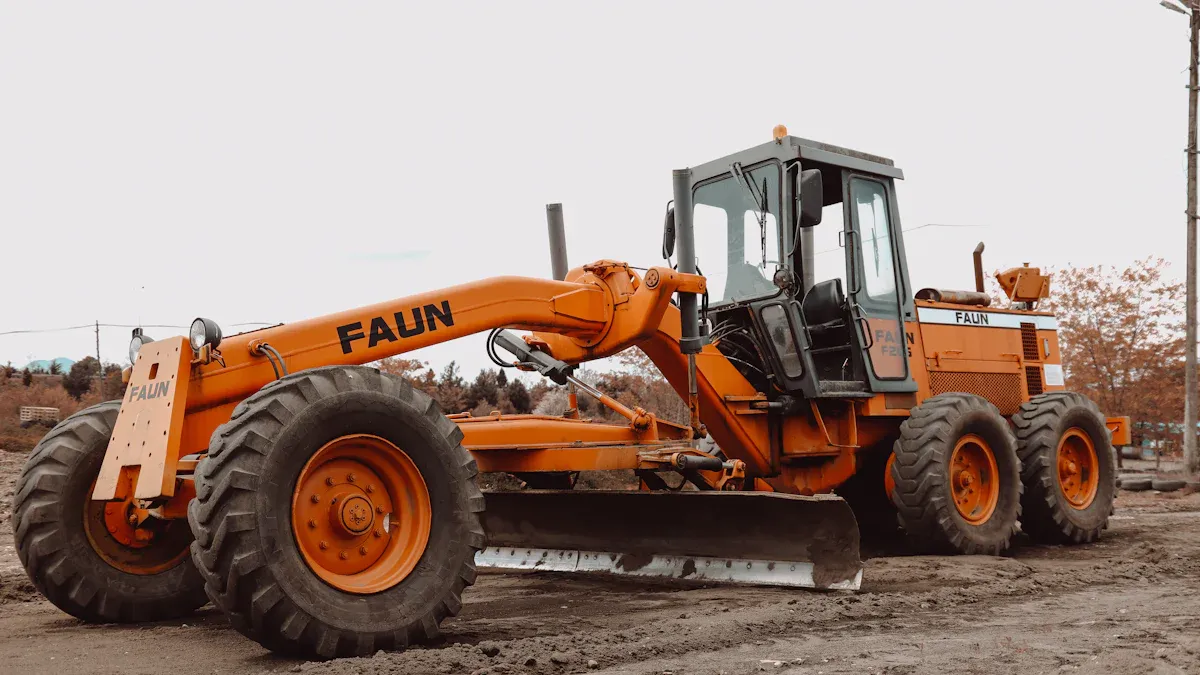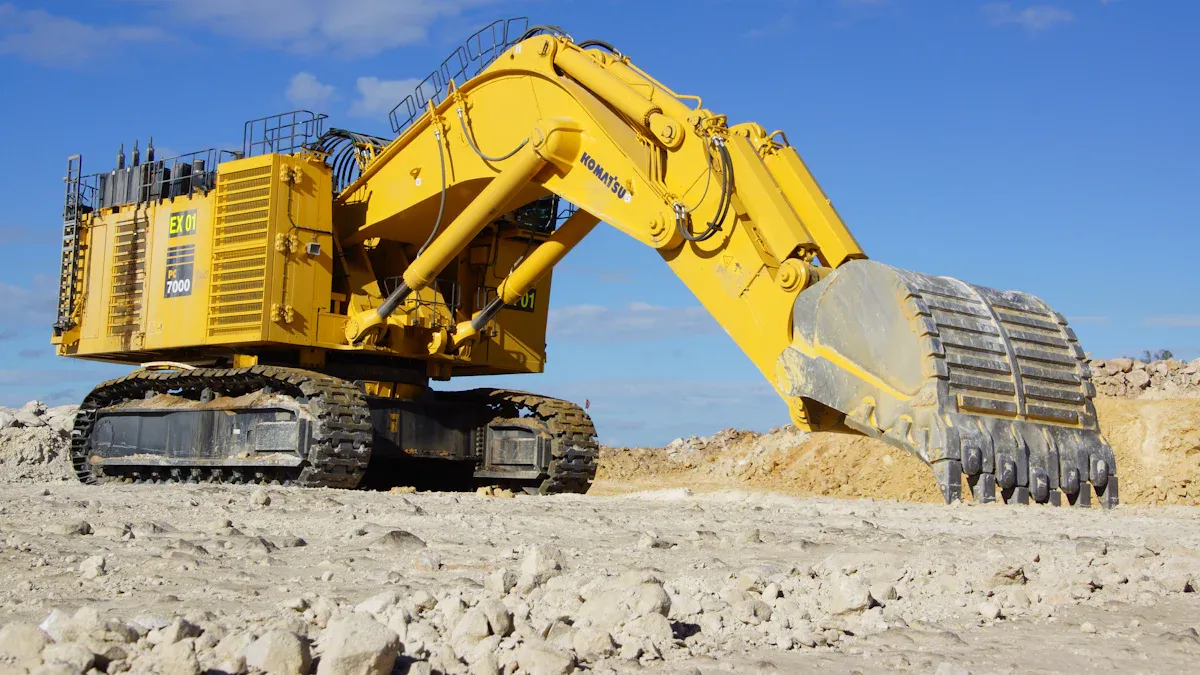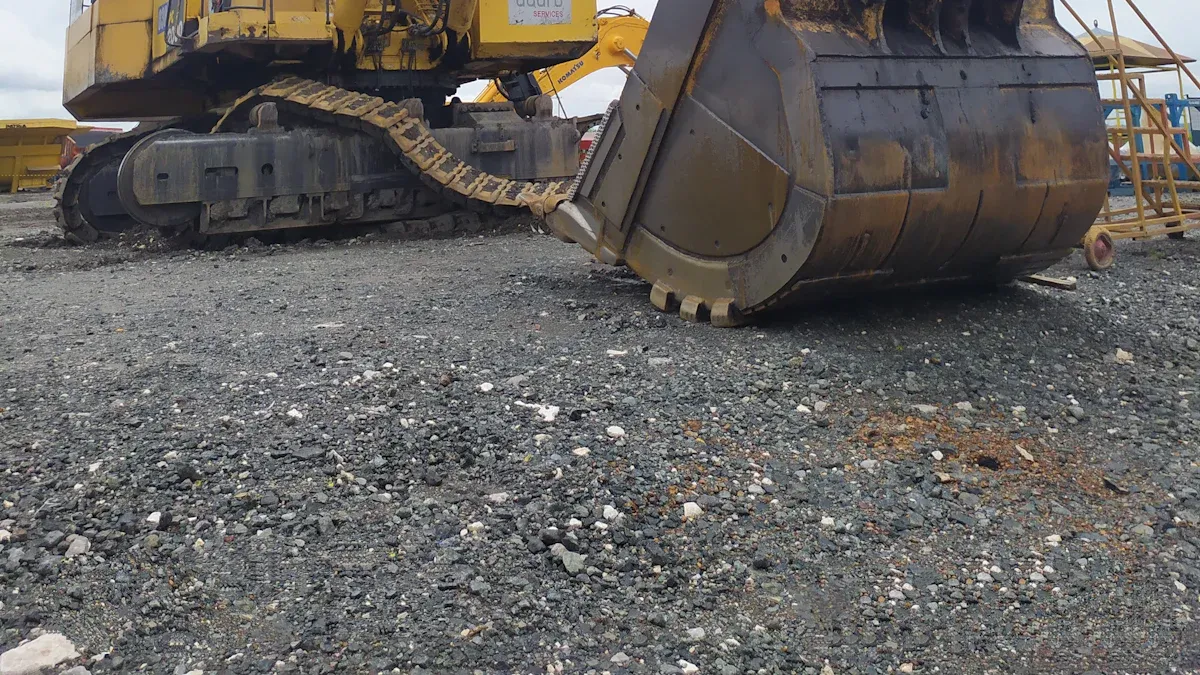
Construction wear parts are vital components in heavy machinery. These parts, designed to withstand extreme wear and tear, play a critical role in maintaining equipment efficiency and prolonging operational lifespan. Their durability directly impacts your machine’s performance by minimizing breakdowns and reducing costly downtime.
Several factors contribute to their longevity. Material quality ensures resistance to harsh conditions. Proper maintenance, including regular inspections, keeps wear parts functioning optimally. Data-driven selection helps you choose parts that align with your equipment’s needs and workload.
The global wear parts market highlights their importance. Industries like mining and construction depend on these parts to maintain machinery. In 2023, the market was valued at USD 20 billion, with projections reaching USD 33 billion by 2033. This growth reflects the increasing demand for durable wear parts to support industrial activities worldwide.

Construction wear parts are essential components that protect heavy machinery from damage caused by constant friction, impact, and abrasion. These parts include items like cutting edges, bucket teeth, and crusher liners, which endure the brunt of demanding tasks. Their primary role is to maintain the efficiency of your equipment by reducing wear on critical machine elements.
When wear parts degrade, several issues arise:
- Increased Cutting Force: Machines require more power to perform tasks, leading to higher energy consumption.
- Decreased Accuracy: Worn tools can produce parts that fail to meet specifications, causing quality concerns.
- Reduced Tool Life: Wear accelerates the need for replacements, increasing operational costs.
By using durable wear parts, you can minimize these challenges and ensure your machinery operates smoothly under tough conditions.
Construction wear parts come in various forms, each tailored to specific applications. Some of the most common types include:
- Bucket Teeth: Used in excavators and loaders, these parts dig into soil and rock while resisting abrasion.
- Cutting Edges: Found on bulldozers and graders, they slice through materials efficiently.
- Crusher Liners: Installed in crushing machines, these liners withstand impact and grinding forces.
- Drill Bits: Essential for drilling operations, they endure high pressure and heat.
Each type plays a unique role in maintaining the performance and durability of your equipment.
The right construction wear parts can significantly enhance your machinery's efficiency and lifespan. Studies show that advanced materials like cemented carbide improve wear resistance, reducing downtime and maintenance costs.
| Aspect | Details |
|---|---|
| Material | Cemented carbide is noted for its exceptional hardness and wear resistance. |
| Performance Benefits | Enhances efficiency and longevity of machinery in industrial applications. |
| Applications | Widely used across various industrial sectors for optimal performance. |
Innovations in lubrication and tribology further reduce friction, ensuring smoother operations and lower energy consumption. By selecting wear parts designed for durability, you can extend the life of your machinery and maximize its productivity.
The materials used in construction wear parts play a critical role in their durability. High-quality materials resist wear and tear better, ensuring your machinery operates efficiently for longer periods. For example, materials like cemented carbide and hardened steel are known for their exceptional hardness and resistance to abrasion. These materials can withstand the constant friction and impact that wear parts endure during heavy-duty tasks.
Different materials behave differently under various conditions. For instance:
- Environmental Impacts: Some materials degrade faster in extreme temperatures or high-moisture environments.
- Mechanical Behavior: Materials that can handle repeated loading and temperature changes last longer.
Advanced testing methods, such as Differential Scanning Calorimetry (DSC) and High-Pressure Thermogravimetric Analysis (HP-TGA), help manufacturers select materials that offer the best performance. By choosing wear parts made from durable materials, you can reduce the frequency of replacements and keep your equipment running smoothly.
The way construction wear parts are made significantly affects their lifespan. Precision manufacturing processes ensure that each part meets strict quality standards. Techniques like heat treatment and surface hardening enhance the strength and wear resistance of materials. These processes create a protective layer on the surface, reducing the impact of friction and abrasion.
Manufacturers also use advanced technologies to improve durability. For example, computer-aided design (CAD) and computer-aided manufacturing (CAM) allow for precise shaping and finishing of wear parts. This precision ensures that the parts fit perfectly with your machinery, reducing unnecessary stress and wear.
When selecting wear parts, look for products from manufacturers that prioritize quality control. Trusted manufacturers often provide certifications that guarantee their parts meet industry standards. This ensures you get reliable components that can handle tough working conditions.
The environment where you use your machinery has a direct impact on the durability of wear parts. Harsh conditions, such as extreme temperatures, heavy moisture, or abrasive materials, can accelerate wear and tear. For example, wear parts used in mining operations face constant exposure to abrasive rocks and dust, which can quickly degrade their surface.
How you use your equipment also matters. Overloading machinery or using it for tasks it wasn’t designed for can put extra stress on wear parts. Regular maintenance and proper usage can help mitigate these effects. Studies show that effective maintenance strategies significantly extend the life of wear parts. By inspecting your equipment regularly and addressing issues early, you can prevent minor problems from turning into costly repairs.
To maximize the lifespan of your wear parts, consider the following tips:
- Use parts designed for the specific conditions of your worksite.
- Avoid overloading your machinery.
- Follow the manufacturer’s guidelines for operation and maintenance.
By understanding how environmental and usage conditions affect wear parts, you can make informed decisions to protect your equipment and reduce downtime.
Data-driven strategies can help you select wear parts that deliver superior performance and cost savings. By analyzing performance metrics, you can identify components that last longer and reduce downtime. Key metrics include:
| Metric | Description |
|---|---|
| Mean Time Between Failures (MTBF) | Tracks the average time between equipment failures, reflecting reliability. |
| Mean Time to Repai r (MTTR) | Measures the average time needed to repair equipment, impacting downtime. |
| Failure Rate | Indicates the likelihood of equipment failure over time. Lower rates mean higher reliability. |
| Availability | Shows the percentage of time equipment is operational. Higher values indicate better performance. |
| Condition Monitoring | Provides real-time data on equipment health to detect early signs of wear. |
For example, using tools like Failure Modes and Effects Analysis (FMEA) allows you to assess potential failure points and prioritize maintenance. Predictive maintenance, which relies on condition monitoring, can save up to 60% of m aintenance costs by addressing issues before they escalate.
Real-world examples also highlight the benefits of data-driven decisions. Products like Road King™ RK52 and C87WT SB Blade Teeth have demonstrated increased tool lifespan and reduced operational costs. These solutions not only minimize downtime but also enhance grading efficiency. By leveraging data, you can make informed choices that improve both performance and cost-effectiveness.
Choosing wear parts that fit your machinery perfectly is essential for optimal performance. Mismatched parts can cause unnecessary stress on your equipment, leading to faster wear and potential damage. T
o ensure compatibility:
- Check the manufacturer’s specifications for yo
ur machinery.
- Use parts designed specifically for your equipment model.
- Consult with exp
erts or suppliers to confirm the right fit.
Compatibility also extends to the operating conditions of your worksite. For instance, if your machinery operates in abrasive environments, select wear parts with enhanced resistance to abrasion. Using the wrong parts can lead to inefficiencies, increased energy consum ption, and higher maintenance costs.
The quality of construction wear parts often depends on the manufacturer. Trusted manufacturers adhere to strict quality standards, ensuring their products perform reliably under tough conditions. Look for certifications that guarantee the parts meet industry requirement s.
Reputable brands like Kennametal offer tooling solutions that enhance productivity and reduce costs. Their products, designed with advanced materials and manufacturing techniques, minimize downtime and extend equipment life. By choosing certified products from trusted manufacturers, you can avoid the risks associated with substandard components.
When evaluating manufacturers, consider their track record and customer reviews. A reliable supplier will provide detailed product information, including material composition and performance data. This transparency helps you make confident decisions and ensures you invest in durable, high-quality wear parts.

Regular inspections are essential for identifying potential issues before they escalate. Proactive maintenance relies on data and analysis to detect early signs of wear , ensuring your machinery operates smoothly. By addressing minor problems promptly, you can prevent costly breakdowns and extend the lifespan of wear parts.
Key benefits of regular inspections include:
- Preventing unexpected equipment failures.
- Enhancing safety by identifying hazards early.
- Reducing repair costs through timely servicing.
- Improving operational efficiency by minimizing downtime.
Industry reports highlight the importance of routine checks. These inspections not only detect abnormalities but also ensure compliance with safety standards. Maintenance logs should document findings, including corrective actions taken, to maintain reliability and performance.
| Benefit | Description |
|---|---|
| Routine Checks | Detect potential issues and ensure smooth operation. |
| Safety Hazard Identification | Identify equipment deficiencies and hazards early. |
| Documentation of Findings | Record abnormalities and corrective actions for future reference. |
| Reliability and Performance | Minimize downtime and costly repairs through diligent maintenance. |
Proper installation plays a critical role in wear part longevity. Incorrect installation can lead to misalignment, increased stress, and premature wear . Following technical guidelines ensures that parts fit correctly and operate efficiently.
Installation manuals provide step-by-step instructions for setup, inspection, and troubleshooting. These guides emphasize the importance of precision during installation to avoid unnecessary str
ain on your equipment. For example:
- Align parts carefully to prevent uneven wear.
- Tighten fasteners to the recommended torque levels.
- Use specialized tools for accurate installation.
By adhering to these practices, you can enhance the durability of wear parts and maintain optimal machine performance.
Cleaning, lubrication, and proper storage are vital f or maintaining wear parts. Regular cleaning removes debris and contaminants that can accelerate wear. Establishing a cleaning schedule and using appropriate products ensures your equipment remains in top condition.
Lubrication minimizes friction and wear, protecting parts from corrosion. A comprehensive lubrication program reduces downtime and extends equipment life. Proactive oil analysis can also detect wear and con tamination early, preventing significant damage.
For storage, keep wear parts in a clean, dry environment to avoid exposure to moisture and dust. Proper storage prevents rust and ensures parts are ready for use when needed. By following these best practice s, you can maximize the lifespan of your wear parts and reduce maintenance costs.
Durability in construction wear parts depends on material quality, precise manufacturing, proper usage, and consistent maintenance. Each factor plays a role in reducing downtime and extending equipment life. A data-driven approach helps you select parts that align with your machinery’s needs, ensuring better performance and cost efficiency.
Preventive maintenance delivers significant benefits. Studies show it can yield up to 500% ROI and reduce maintenance time by 75%.
| Benefit Type | Description |
|---|---|
| ROI of Preventive Maintenance | Potential ROI of up to 500% from preventive maintenance programs. |
| Cost Savings | Predictive maintenance saves 12% compared to reactive methods. |
| Safety and Compliance | Regular maintenance ensures safety and avoids legal penalties. |
Prioritize durable parts and proactive care to maximize your equipment’s potential while minimizing costs.
Look f or visible cracks, uneven wear, or reduced performance. If your machinery requires more power or produces inconsistent results, the wear parts may have degraded. Regular inspections help you identify these issues early.
Inspect wear parts after every 100 hours of operation or as recommended by the manufacturer. Frequent checks ensure you catch wear and tear before it leads to equipment failure.
Generic parts may not meet the same quality standards as branded ones. They might not fit perfectly or last as long. Always prioritize certified parts from trusted manufacturers for better performance and durability.
Proper storage prevents rust, corrosion, and contamination. Keep wear parts in a clean, dry area away from moisture and dust. This ensures they remain in optimal condition until needed.
Follow a proactive maintenance routine. Clean and lubricate parts regularly. Avoid overloading machinery and use parts designed for your specific equipment and work conditions. These practices reduce wear and maximize lifespan.